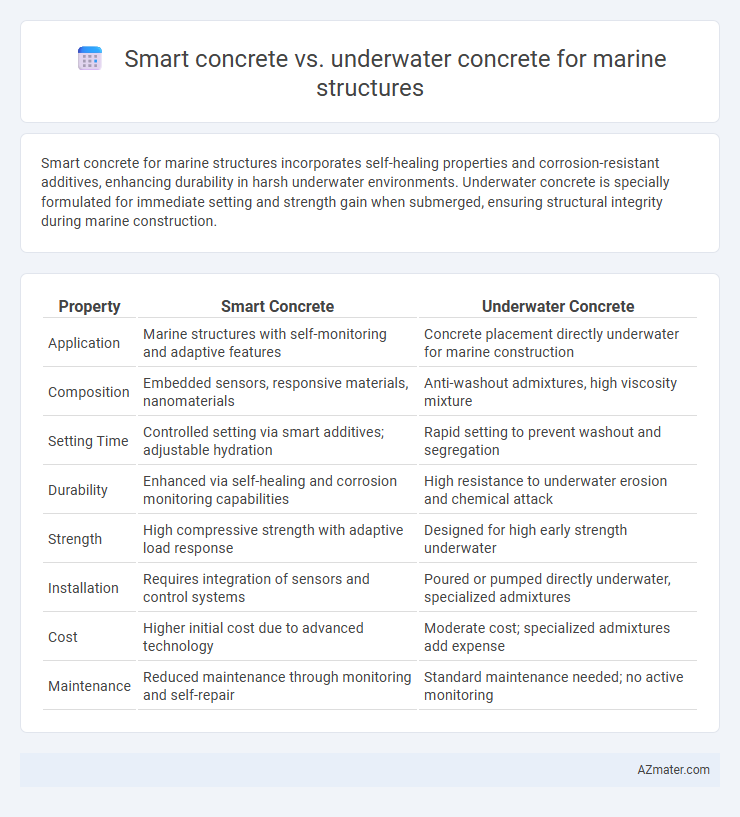Smart concrete for marine structures incorporates self-healing properties and corrosion-resistant additives, enhancing durability in harsh underwater environments. Underwater concrete is specially formulated for immediate setting and strength gain when submerged, ensuring structural integrity during marine construction.
Table of Comparison
| Property | Smart Concrete | Underwater Concrete |
|---|---|---|
| Application | Marine structures with self-monitoring and adaptive features | Concrete placement directly underwater for marine construction |
| Composition | Embedded sensors, responsive materials, nanomaterials | Anti-washout admixtures, high viscosity mixture |
| Setting Time | Controlled setting via smart additives; adjustable hydration | Rapid setting to prevent washout and segregation |
| Durability | Enhanced via self-healing and corrosion monitoring capabilities | High resistance to underwater erosion and chemical attack |
| Strength | High compressive strength with adaptive load response | Designed for high early strength underwater |
| Installation | Requires integration of sensors and control systems | Poured or pumped directly underwater, specialized admixtures |
| Cost | Higher initial cost due to advanced technology | Moderate cost; specialized admixtures add expense |
| Maintenance | Reduced maintenance through monitoring and self-repair | Standard maintenance needed; no active monitoring |
Introduction to Marine Concrete Technologies
Smart concrete incorporates advanced materials like self-healing polymers and sensors to enhance durability and monitor structural health in marine environments. Underwater concrete, designed for placement directly in submerged conditions, utilizes anti-washout admixtures and controlled rheology to maintain integrity during underwater curing. Both technologies address marine challenges such as corrosion, hydrostatic pressure, and chloride penetration, optimizing performance for coastal and offshore infrastructure.
Defining Smart Concrete and Its Key Features
Smart concrete in marine structures integrates advanced materials like self-healing agents, sensors, and nano-additives to enhance durability and monitor structural health in real-time. Key features include self-repair capabilities triggered by environmental changes, improved resistance to chloride ion penetration, and embedded sensors providing continuous data on stress and corrosion. Underwater concrete, while designed for placement in aquatic environments, lacks these adaptive properties, relying instead on rapid setting and impermeability to withstand marine conditions.
Understanding Underwater Concrete: Composition & Usage
Underwater concrete for marine structures typically consists of a mix with anti-washout admixtures, higher cement content, and coarser aggregates to ensure cohesion and workability in submerged conditions. Its composition allows for placement directly underwater without segregation or dilution, making it essential for building stable marine foundations, piers, and retaining walls. This type of concrete is engineered to resist washout, maintain consistency during placement, and achieve durability against marine environmental factors such as chloride ion penetration and sulfate attack.
Performance Requirements for Marine Structures
Smart concrete enhances marine structures with superior durability, self-healing capabilities, and real-time structural health monitoring, ensuring long-term performance under harsh marine conditions. Underwater concrete is specifically designed for rapid setting and high strength in submerged environments, providing essential resistance to seawater corrosion and washout. Both materials meet critical performance requirements by addressing durability, structural integrity, and environmental adaptability for marine applications.
Durability and Longevity Comparison
Smart concrete incorporates self-healing properties and enhanced microstructure to significantly improve durability against marine environment aggressors such as chloride ions and sulfates, reducing maintenance needs and extending service life. Underwater concrete, designed for placement directly in aquatic conditions, typically features high water retention and anti-washout admixtures, ensuring early strength gain and cohesive integrity but may be more susceptible to long-term degradation due to prolonged exposure to saltwater. Comparative studies indicate smart concrete offers superior longevity and crack resistance, making it more effective for sustainable marine structures exposed to harsh underwater conditions.
Structural Strength and Load-Bearing Capabilities
Smart concrete integrates advanced materials like carbon nanotubes and self-healing agents, significantly enhancing structural strength and load-bearing capabilities in marine structures by reducing micro-cracks and improving durability. Underwater concrete, formulated for high cohesion and rapid setting in submerged conditions, offers robust load-bearing capacity but may face limitations in long-term durability due to exposure to aggressive marine environments. Comparative studies indicate smart concrete outperforms traditional underwater concrete in resisting mechanical stresses and extending service life of marine infrastructure.
Resistance to Corrosion and Marine Aggression
Smart concrete incorporates self-healing agents and corrosion inhibitors that enhance resistance to chloride ion penetration and marine biofouling, significantly reducing deterioration in marine environments. Underwater concrete, typically designed with anti-washout admixtures and dense cementitious matrices, provides immediate placement and improved setting underwater but is more susceptible to long-term corrosion from seawater exposure. The integration of smart concrete technologies offers superior durability and sustained protection against aggressive marine conditions compared to traditional underwater concrete used in marine structures.
Cost Efficiency and Lifecycle Analysis
Smart concrete enhances cost efficiency in marine structures by reducing maintenance expenses through its self-healing properties, which extend the lifecycle compared to traditional underwater concrete that often requires frequent repairs due to water-induced deterioration. Lifecycle analysis reveals that smart concrete's advanced additives and sensors contribute to longer durability and monitoring capabilities, offsetting its initial higher material costs and resulting in lower total ownership costs. Underwater concrete, while initially cheaper and easier to place, tends to have higher lifecycle costs due to susceptibility to chemical attacks and physical degradation in marine environments.
Technological Innovations in Smart and Underwater Concretes
Smart concrete integrates self-sensing capabilities through embedded sensors and conductive materials that monitor structural health, improving durability and maintenance efficiency for marine structures. Underwater concrete employs advanced admixtures and anti-washout agents to enhance cohesion and setting properties, ensuring stability and resistance to saline environments during submerged placement. Technological innovations in these concretes optimize performance by combining real-time data acquisition with specialized chemical formulations tailored for harsh marine conditions.
Choosing the Right Concrete Solution for Marine Applications
Smart concrete offers enhanced durability and self-healing properties, making it ideal for marine structures exposed to harsh environments and chlorides. Underwater concrete provides excellent placement and bonding capabilities directly in submerged conditions, ensuring structural integrity in marine applications. Selecting the right concrete depends on project requirements such as exposure conditions, load demands, and long-term maintenance considerations.

Infographic: Smart concrete vs Underwater concrete for Marine structure
 azmater.com
azmater.com